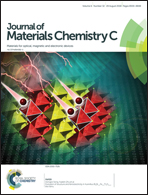Towards the application of Al2O3/ZnO nanolaminates in immunosensors: total internal reflection spectroscopic ellipsometry based evaluation of BSA immobilization
Abstract
In this research Al2O3/ZnO nanolaminates were evaluated for possible application in the design of optical immunosensors. Total internal reflection ellipsometry (TIRE) was utilized to study the optical response during the formation of a bovine serum albumin (BSA) based monolayer on the surface of Al2O3/ZnO nanolaminates, which were pre-modified with a N-(3-aminopropyl)triethoxysilane (APTES) layer. The influence of the thicknesses of Al2O3 and ZnO layers on the performance of Al2O3/ZnO nanolaminate based structures has been assessed. This research has shown the noticeable contribution of multiple reflections from the interfaces between Al2O3 and ZnO for the enhancement of the optical response in a total internal reflection configuration. Al2O3/ZnO nanolaminates of 200 nm total thickness based on four 50 nm thick alternating Al2O3 and ZnO layers have shown better sensitivity than the nanolaminate based on two 100 nm oxide-layers. Real-time monitoring of the ellipsometric parameters Ψ(λ) and Δ(λ) has shown that BSA was successfully covalently attached to the nanolaminate/APTES surface. The surface concentration of immobilized BSA was evaluated from the real-time data of the ellipsometric parameters Ψ(λ) and Δ(λ). The expected advantages and disadvantages of Al2O3/ZnO nanolaminates during expected application in optical immunosensors are discussed.



 Please wait while we load your content...
Please wait while we load your content...